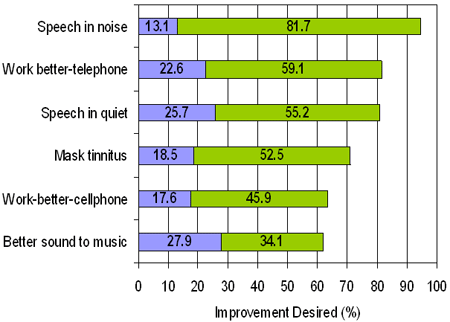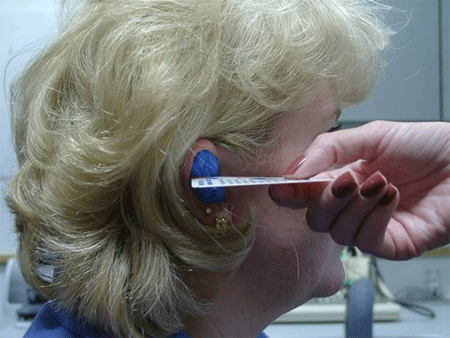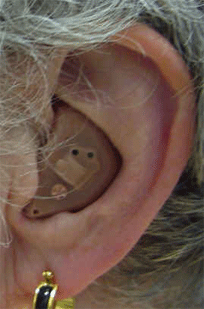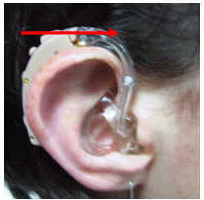The hearing aid industry has made significant strides regarding the fidelity and sophistication of hearing aid signal processing and fitting strategies for state-of-the-art hearing aids. Nonetheless, understanding speech in noise continues to be the chief complaint of people wearing hearing aids (see Figure 1; Kochkin, 2002). Hearing healthcare providers are challenged to provide the best hearing solution for each patient, while offering hearing aid fitting strategies that improve speech understanding in noise.
As such, the search for a "noise" solution has been demanding, partially based on the myriad of amplification choices, and partially based on the difficulty of the task itself - eliminating or reducing some voices, while maximizing perception of others!
However, one effective and proven method to accomplish this goal is not complex or mysterious. In fact, directional processing remains the ONLY proven signal processing approach to improve speech recognition in noise, once audibility has been maximized. Moreover, many obstacles associated with directional hearing aids have been recently solved or dramatically improved: cosmetic concerns, size, directional performance, noise performance and stability over time.
Hearing devices that provide directional processing can effectively improve speech understanding in noise.

Figure 1. Benefit (purple) and desired improvement (green) for various dimensions of hearing aid satisfaction. From Kochkin (2002).
Of course, this begs the question...If directional processing increases speech understanding in noise, why do some patients fit with this solution, not take advantage of it?
According to Cord and colleagues (2002), although patients receive counseling on how to use directional hearing devices, many patients do not. Twenty-three percent of patients in their study noted various reasons for not changing memories while using multi-memory directional products. Reasons included; not understanding the different settings in their hearing aids, not noticing differences between the alternate directional modes, not wanting to bother changing from the omni-directional (default) memory. Additionally, dexterity problems and/or mental capacity may be intervening factors too.
Therefore, providing a hearing device that can instantly determine which directional mode (omni-directional or directional) to use for maximal speech perception in any environment and switching automatically to the directional mode of choice, would present a significant solution for speech understanding in noise.
In developing an automatic device, knowledge of the environments in which omni-directional and directional processing strategies are preferred, are among the first concerns. Research conducted at Walter Reed Army Medical Center focused on identifying these situations and defined various environments in which subjects preferred directional processing, and environments in which they preferred omni-directional processing (Surr, et al., 2002; Walden et al., 2003). Their results suggested that when the primary speech signal is in front of the listener and nearby, and when background noise is present, a directional algorithm is preferred. On the other hand, when the signal originates far away from the listener or does not originate in front, and if background noise is present and in the front, listeners prefer omni-directional processing. If background noise is absent, listeners tend to prefer omni-directional algorithms.
The success of an automatic, directional, switchless system, would likely be related to it's ability to accurately identify the acoustic environment, the preferred directional protocol and to "seamlessly" and automatically switch to the preferred directional program.
Research on an automatic device (Olson, et al., 2004) verified the accuracy achievable with such a device. Results demonstrated that for the majority of situations, the automatic algorithm picked the appropriate/preferred mode, omni-directional or directional, 89% of the time.
For example, while riding in an automobile, the algorithm switched appropriately 85% of the time (11 out of 13 reports of correct switching). While eating dinner at home and while watching TV, the algorithm switched appropriately 100% and 94% of the time, respectively. In restaurant situations, the most diverse environment, and an environment where hearing aid wearers frequently struggle to hear, and an environment in which subjects had more individual preferences, the algorithm switched appropriately 77% of the time.
These results suggest that hearing healthcare professionals can feel confident about providing patients with hearing devices that automatically select and switch to appropriate directional amplification strategies for quiet and noisy environments.
Fitting Considerations:
Automatic directional hearing devices rely on two critical fitting considerations not driven by advanced digital technology!
- Proper ear impression techniques for maximal alignment of custom made hearing aids with directional microphones.
- Proper counseling strategies.
Research indicates that deviations of greater than 15 degrees from the horizontal plane significantly reduce the directivity of the devices (Ricketts 2000a). Without good directivity, the potential benefit of understanding speech in noise is significantly reduced.
To accomplish this, the patient should sit in a normal, natural and comfortable position while the earmold impression is obtained. Once the earmold material begins to cure, a horizontal line should be scored into the material. Many manufacturers supply an impression card to accomplish this, but if the card is not available, a warranty card, business card, credit card, or a package of batteries may be a useful substitute.
Marking the earmold impression material with a pen/marker is not recommended. The ink can smudge or disappear with most impression materials.
The manufacturer will use the horizontal line as a guide to align the directional microphones in the proper plane (see Figure 2).
Once the custom hearing device is built, and after it has been initially placed in the ear of the patient, the hearing healthcare professional should check the horizontal alignment and orientation of the microphones (see Figure 3).
Proper microphone alignment is also important for Behind-The-Ear (BTE) fittings. When fitting BTEs, the microphones need to be in the horizontal plane, as is required for custom made devices. To accomplish this, the hearing healthcare professional should take care in placing the instrument on the ear and cutting the earmold tubing (see Figure 4).

Figure 2: Marking horizontal plane on the earmold impression.

Figure 3: Checking alignment of the microphones after the hearing devices are manufactured.

Figure 4: Checking alignment of the microphones on a BTE.
Lastly, once the hearing aid is properly fit and verification of the alignment of the microphones has been completed, the patient should be counseled on strategies for correct usage of a directional instrument.
In general, beyond knowing the hearing aid will automatically adjust to the acoustic environment, the patient should be counseled to favorably manipulate his/her listening environment to provide the maximal speech to noise ratio. Using management strategies to separate the speech of interest from the background noise will prove to be useful. This may involve having the patient relocate themselves so the position of the primary speech signal is in front of the patient and the primary noise source is behind.
Reviewing practical examples and offering written notes as to where to sit in a restaurant, where to stand on a busy street corner, or how to position one's self for maximal conversational speech intelligibility will help the patient understand and retain the information.
For example, in a noisy restaurant, it is typically advantageous for the patient to place his/her communication partner directly across the table from himself/herself, with the majority of the patrons behind. On a busy and noisy street corner, the patient ideally should stand between the person speaking and the road noise, with the noise originating from behind the patient. Of course, each listening situation is unique involving many factors such as changing speech to noise ratios, voice characteristics and familiarity of the person speaking, acoustic characteristics of the background noise, reverberation time, and type and degree of hearing loss, to name just a few.
Although a comprehensive description of counseling is beyond the scope of this article, acknowledging the ongoing importance of exploring and re-evaluating communicative strategies for unique acoustic environments, and understanding how this enhances directional processing, will help ensure a successful experience.
Margolis (2004) noted that there are many communicative strategies to help maximize recall and the recollection of the patient, as to the specific message the hearing healthcare professional is attempting to deliver. These issues and strategies (extrapolated and paraphrased below) are just as important with respect to overall counseling relating to general health and well being, as they are to maximal speech perception with directional hearing aids.
- Advice should be concrete and non-ambiguous. Margolis stated his preference for ''Use ear plugs with power tools.'' rather than, ''Keep noise exposure to a minimum.''
- Use easy to understand language. Short words and sentences are remembered better.
- Present the most important information first to capitalize on the "primacy effect."
- Use "explicit categorization." Tell the patient what you're going to discuss, then discuss it, then review it. Ask the patient for questions before moving on to the next issue.
- Repeat the most important information.
- Don't present too much information. Present only the information that is important for the patient to remember. Proportion of retention decreases with the amount of information presented.
- Specifically address the patient's desires and beliefs.
- Supplement verbal information with written, graphical, and pictorial materials that the patient can take home.
Solving the number one complaint of hearing aid users ( i.e., speech intelligibility in noise) is a multi-faceted process. A high quality dynamic directional hearing aid with excellent directivity ability is pivotal. Additionally, custom made hearing aids will need accurate and well defined horizontal microphone markings, while BTEs must be accurately placed on the ear for maximal directional performance. Appropriate counseling, with due respect to information transfer and retention by the patient, regarding realistic expectations from their hearing aids and their personal management of the acoustic environment will also contribute to successful hearing aid experiences.
References:
Cord, M.T., R.K. Surr, et al (2002). "Performance of directional microphone hearing aids in everyday life." Journal of the American Academy of Audiology 6: 295-307.
Kochkin, S.(2002). 10-Year Customer Satisfaction Trends in the US Hearing Instrument Market. The Hearing Review 9(10): 14-25, 46.
Margolis, Robert, M.: "In one ear and out the other - What patients remember" 2-23-2004 Audiology Online: www.audiologyonline.com/articles/arc_disp.asp?id=548&catid=3
Olson, L, M. Ioannou, T.D. Trine, (2004). "Appraising an automatic directional device in real-world environments". Hearing Journal 57 (6): (32-38).
Ricketts, T. (2000a). "Directivity quantification in hearing aids: Fitting and measurement effects." Ear and Hearing 21(1): 45-58.
Surr, R. K., B. E. Walden, et al. (2002). "Influence of environmental factors on hearing aid microphone preference." Journal of the American Academy of Audiology 13: 308-322.
Walden, B.E., R.K. Surr, et al (2003). "Predicting hearing aid microphone preference in everyday listening. "Presented to the 2003 convention of the American Academy of Audiology, San Antonio, TX

